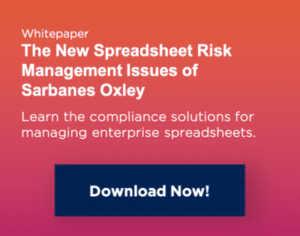Spreadsheets are critical tools for organizations across all industries, but they also present significant operational, financial, and regulatory risks when not properly controlled.
As the complexity of End-User Computing (EUC) tools like spreadsheets increases, so too does the risk of error. A recent study reveals that up to 94% of spreadsheets used for business decisions have critical errors.
As organizations continue to rely on EUC tools, the potential for errors grows, leading to financial losses, compliance issues, and reputational damage. One of the most effective ways to combat this issue is through a comprehensive EUC audit.
What is an EUC audit?
An EUC (End-User Computing) audit is a structured process that evaluates the risks, controls, and governance practices surrounding end-user applications, most commonly spreadsheets and other tools created outside of IT oversight. These tools often support key business functions such as financial reporting, risk management, forecasting, and compliance tracking.
An EUC audit typically includes the following objectives:
- Identifying critical EUCs across departments
- Assessing risk levels based on complexity, usage, and data sensitivity
- Evaluating controls such as access restrictions, version control, and error handling
- Recommending improvements or automation opportunities
Why is an EUC Audit Necessary for Compliance?
Regulators have become increasingly aware of the risks posed by uncontrolled EUC tools. Failing to manage these risks can lead to compliance violations, inaccurate financial reporting, and reputational damage. Conducting regular EUC audits helps organizations stay compliant with a growing list of regulatory frameworks, including:
- Sarbanes-Oxley Act (SOX): Requires internal controls over financial reporting. Spreadsheets used in financial processes must be documented, controlled, and auditable.
- General Data Protection Regulation (GDPR): Mandates strong controls over the processing and storage of personal data, which may reside in EUCs.
- UK Financial Conduct Authority (FCA): Requires firms to manage operational risk, including risks posed by EUC tools that support critical business operations.
- SEC Rules and Guidance: The U.S. Securities and Exchange Commission expects robust risk management practices for firms using EUC tools in disclosures or financial reporting.
Auditing your EUC environment ensures that spreadsheets and other user-created tools are accurate and secure and align with these regulatory expectations.
How to Conduct an EUC Audit
1. Create an Inventory
Start by identifying all critical EUCs across the organization. This can be done manually via surveys or, more effectively, through an EUC inventory management system. Having an up-to-date inventory is essential for SOX compliance.
2. Risk Rank the EUC’s
Apply a standard risk-ranking methodology based on factors like:
- Häufigkeit der Nutzung
- Financial or operational impact
- Complexity of formulas and links
Tools with built-in risk assessment capabilities can accelerate this process.
3. Assess Access and Security Controls
Determine who has access to each EUC file, especially those stored on shared drives. For files containing sensitive or regulated data, apply password protection and enable encryption.
4. Review Input Controls
Assess how data is entered. Are there validation rules in place? Do inputs prevent the entry of incorrect formats (e.g., enforcing text-only fields)?
5. Validate Calculations and Formulas
Review all calculations separately to verify their accuracy. Test for consistency, logic, and duplication errors across multiple sheets or links.
6. Evaluate Outputs and Distribution
Confirm whether reports generated from the EUC are accurate. Check who receives the output, ensuring distribution aligns with business or compliance needs.
7. Review Change & Version Control
Identify how changes are tracked. Use tools that monitor versions and highlight alterations so that updates can be tested, approved, and rolled out securely.
Ongoing EUC Management Best Practices
Die Durchführung eines effektiven EUC-Audits ist eine wichtige Fähigkeit zur Risikominderung. Auch im Hinblick auf ein kontinuierliches Management kann viel getan werden, um die Gefahr für Ihr Unternehmen zu minimieren. Im Folgenden erläutern wir die Managementstrategien, die Sie anwenden sollten, um Ihre Daten und Prozesse zu schützen.
Centralize Storage
Ensure all business-critical EUCs are stored in a shared, secure, and centralized location accessible by relevant teams. Consider segmenting by department or function for access control.
Simplify Documentation
Use standardized templates and embed documentation requirements into everyday workflows. This encourages end users to follow risk mitigation best practices without added friction.
Gather Data to Quantify EUC Risk
With objective, quantifiable data, you can evaluate each EUC side by side, understanding the levels of risk within different areas of the organization.
Collect measurable data about each EUC, such as:
- Number of worksheets
- External data links
- Use of macros or complex formulas
You can also gather insights through user questionnaires (e.g., “Is this file used in external reporting?” or “Does it contain personally identifiable information?”).
Leverage Existing Technology for Risk Mitigation
Leverage dedicated solutions to help you gather evidence and improve your overall EUC management. Key components to provide immediate risk mitigation may include:
- Encryption – Protect shared EUC drives from unauthorized access.
- Scanning – Identify and assess spreadsheet complexity.
- Data Loss Prevention(DLP) – Prevent sensitive information from being accidentally shared outside the organization.
Automate EUC Risk Management
Even with best practices in place, human error is inevitable. Automating EUC monitoring, version control, and access management reduces reliance on manual oversight and ensures consistent enforcement of risk controls.
Next Steps: Safeguard Your Organization from Spreadsheet Risk
Reliance on EUC tools like spreadsheets isn’t going away, nor is the risk to your organization. A thorough EUC audit mitigates these risks and helps maintain regulatory compliance. Creating a structured, automated, well-documented EUC management process can reduce exposure, improve data integrity, and build confidence in your organization’s critical operations. Schedule a demo with our expert team today to see how Mitratech can help safeguard your operations and automate EUC risk management.



